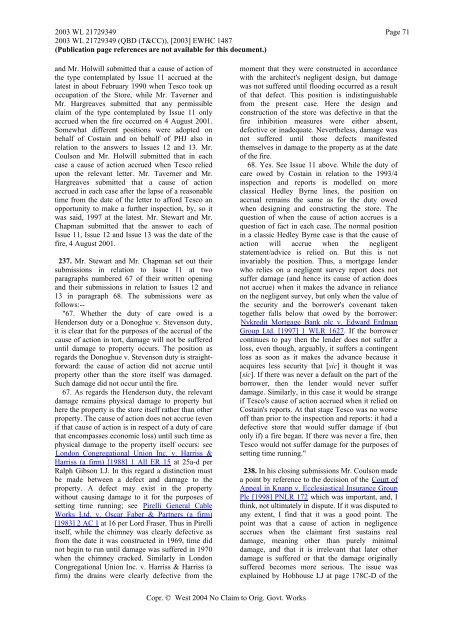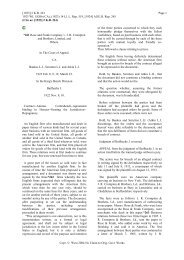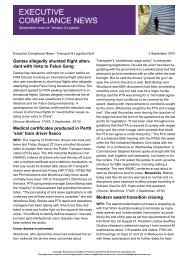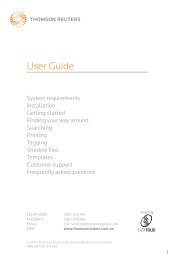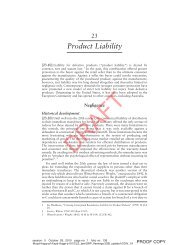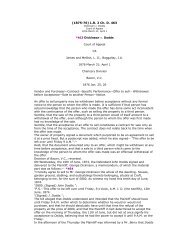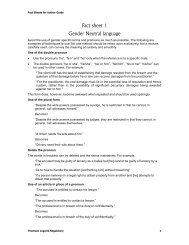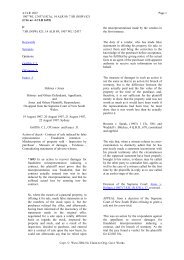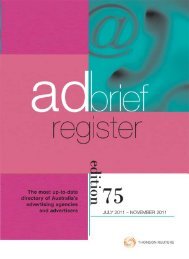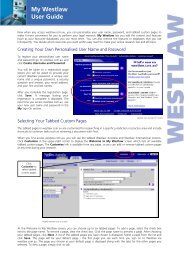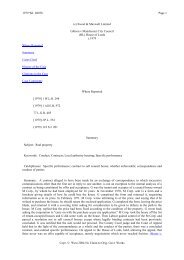Tesco v Constain - Thomson Reuters
Tesco v Constain - Thomson Reuters
Tesco v Constain - Thomson Reuters
You also want an ePaper? Increase the reach of your titles
YUMPU automatically turns print PDFs into web optimized ePapers that Google loves.
2003 WL 21729349 Page 712003 WL 21729349 (QBD (T&CC)), [2003] EWHC 1487(Publication page references are not available for this document.)and Mr. Holwill submitted that a cause of action ofthe type contemplated by Issue 11 accrued at thelatest in about February 1990 when <strong>Tesco</strong> took upoccupation of the Store, while Mr. Taverner andMr. Hargreaves submitted that any permissibleclaim of the type contemplated by Issue 11 onlyaccrued when the fire occurred on 4 August 2001.Somewhat different positions were adopted onbehalf of Costain and on behalf of PHJ also inrelation to the answers to Issues 12 and 13. Mr.Coulson and Mr. Holwill submitted that in eachcase a cause of action accrued when <strong>Tesco</strong> reliedupon the relevant letter. Mr. Taverner and Mr.Hargreaves submitted that a cause of actionaccrued in each case after the lapse of a reasonabletime from the date of the letter to afford <strong>Tesco</strong> anopportunity to make a further inspection, by, so itwas said, 1997 at the latest. Mr. Stewart and Mr.Chapman submitted that the answer to each ofIssue 11, Issue 12 and Issue 13 was the date of thefire, 4 August 2001.237. Mr. Stewart and Mr. Chapman set out theirsubmissions in relation to Issue 11 at twoparagraphs numbered 67 of their written openingand their submissions in relation to Issues 12 and13 in paragraph 68. The submissions were asfollows:--"67. Whether the duty of care owed is aHenderson duty or a Donoghue v. Stevenson duty,it is clear that for the purposes of the accrual of thecause of action in tort, damage will not be suffereduntil damage to property occurs. The position asregards the Donoghue v. Stevenson duty is straightforward:the cause of action did not accrue untilproperty other than the store itself was damaged.Such damage did not occur until the fire.67. As regards the Henderson duty, the relevantdamage remains physical damage to property buthere the property is the store itself rather than otherproperty. The cause of action does not accrue (evenif that cause of action is in respect of a duty of carethat encompasses economic loss) until such time asphysical damage to the property itself occurs: seeHLondon Congregational Union Inc. v. Harriss &Harriss (a firm) [1988] 1 All ER 15 at 25a-d perRalph Gibson LJ. In this regard a distinction mustbe made between a defect and damage to theproperty. A defect may exist in the propertywithout causing damage to it for the purposes ofsetting time running; see HPirelli General CableWorks Ltd. v. Oscar Faber & Partners (a firm)[1983] 2 AC 1 at 16 per Lord Fraser. Thus in Pirelliitself, while the chimney was clearly defective asfrom the date it was constructed in 1969, time didnot begin to run until damage was suffered in 1970when the chimney cracked. Similarly in LondonCongregational Union Inc. v. Harriss & Harriss (afirm) the drains were clearly defective from themoment that they were constructed in accordancewith the architect's negligent design, but damagewas not suffered until flooding occurred as a resultof that defect. This position is indistinguishablefrom the present case. Here the design andconstruction of the store was defective in that thefire inhibition measures were either absent,defective or inadequate. Nevertheless, damage wasnot suffered until those defects manifestedthemselves in damage to the property as at the dateof the fire.68. Yes. See Issue 11 above. While the duty ofcare owed by Costain in relation to the 1993/4inspection and reports is modelled on moreclassical Hedley Byrne lines, the position onaccrual remains the same as for the duty owedwhen designing and constructing the store. Thequestion of when the cause of action accrues is aquestion of fact in each case. The normal positionin a classic Hedley Byrne case is that the cause ofaction will accrue when the negligentstatement/advice is relied on. But this is notinvariably the position. Thus, a mortgage lenderwho relies on a negligent survey report does notsuffer damage (and hence its cause of action doesnot accrue) when it makes the advance in relianceon the negligent survey, but only when the value ofthe security and the borrower's covenant takentogether falls below that owed by the borrower:HNykredit Mortgage Bank plc v. Edward ErdmanGroup Ltd. [1997] 1 WLR 1627. If the borrowercontinues to pay then the lender does not suffer aloss, even though, arguably, it suffers a contingentloss as soon as it makes the advance because itacquires less security that [sic] it thought it was[sic]. If there was never a default on the part of theborrower, then the lender would never sufferdamage. Similarly, in this case it would be strangeif <strong>Tesco</strong>'s cause of action accrued when it relied onCostain's reports. At that stage <strong>Tesco</strong> was no worseoff than prior to the inspection and reports: it had adefective store that would suffer damage if (butonly if) a fire began. If there was never a fire, then<strong>Tesco</strong> would not suffer damage for the purposes ofsetting time running."238. In his closing submissions Mr. Coulson madea point by reference to the decision of the HCourt ofAppeal in Knapp v. Ecclesiastical Insurance GroupPlc [1998] PNLR 172 which was important, and, Ithink, not ultimately in dispute. If it was disputed toany extent, I find that it was a good point. Thepoint was that a cause of action in negligenceaccrues when the claimant first sustains realdamage, meaning other than purely minimaldamage, and that it is irrelevant that later otherdamage is suffered or that the damage originallysuffered becomes more serious. The issue wasexplained by Hobhouse LJ at page 178C-D of theCopr. © West 2004 No Claim to Orig. Govt. Works


